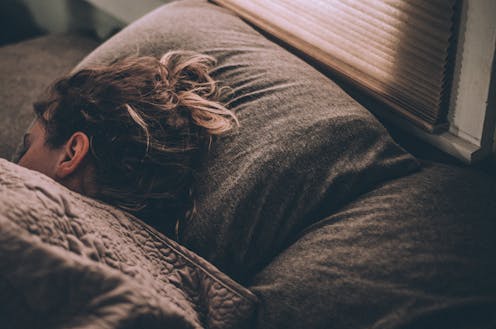On your back? Side? Face-down? Mice show how we sleep may trigger or protect our brain from diseases like ALS
- Written by David Wright, Associate Professor of Medical Imaging, Monash University

Amyotrophic lateral sclerosis (ALS), also known as Lou Gehrig’s disease, is the most common form of motor neuron disease. People with ALS progressively lose the ability to initiate and control muscle movements, including the ability to speak, swallow and breathe.
There is no known cure. But recently, we studied mice and identified a new target in the fight against this devastating disease: the brain’s waste clearance system.
Neurodegenerative diseases – including Parkinson’s disease, Alzheimer’s and multiple sclerosis – share many similarities, even though their clinical symptoms and disease progression may look very different. The incidence of these diseases increase with age. They are progressive and relentless, and result in gradual loss of brain tissue. We also see waste proteins accumulate in the brain.
Our new research looked at how the glymphatic system, which removes waste from the brain, could prevent ALS.
Protein chains, folds and misfolds
Inside our bodies, long protein chains fold to form functional shapes that allow them to perform specific tasks like creating antibodies to fight off infection, supporting cells or transporting molecules.
Sometimes this process goes awry, resulting in “misfolded” proteins that clump together to form aggregates. Misfolded protein can grow and fragment, creating seeds that spread throughout the brain to form new clusters.
The accumulation of waste proteins begins early in the neurodegenerative disease process – well before the onset of symptoms and brain loss. As researchers, we wanted to see if eliminating or slowing the spread of these waste proteins and their seeds could halt or slow the progression of disease.
Targeting waste removal
The glymphatic system removes waste, including toxic proteins, from the brain.
This brain-wide network of fluid-filled spaces, known as Virchow-Robin spaces, is mostly switched off while we’re awake. But it kicks into gear during sleep to distribute compounds essential to brain function and to get rid of toxic waste.
This may explain why all creatures, great and small (even flies), need sleep to survive. (Interestingly, whales and dolphins alternate their sleep between brain hemispheres, keeping the other hemisphere awake to watch for predators and alerting them to breathe!)
As we age, sleep quality declines and the risk of neurodegenerative disease, including ALS, increases.
Sleep disturbances are also a common symptom of ALS and research has shown a single night without sleep can result in increased accumulation of toxic waste protein in the brain. As such, we thought glymphatic function might be impaired in ALS.
Read more: Longer naps in the day may be an early sign of dementia in older adults
Ageing mice
To investigate this, we looked to mice. The animals were genetically modified to express human TDP-43 – the protein implicated in ALS. By feeding these mice food containing an antibiotic (doxycycline), we were able to turn the TDP-43 protein expression off and they aged normally. But when the mice are switched to normal food, TDP-43 expression is turned on and misfolded proteins begin to accumulate.
Over time, the mice display the classical signs of ALS including progressive muscle impairments and brain atrophy.
Using magnetic resonance imaging (MRI) to see brain structure, we investigated glymphatic function in these mice just three weeks after turning on TDP-43 expression.
As we watched the glymphatic system go to work, we saw the TDP-43 mice had worse glymphatic clearance than the control mice that had not been genetically modified. Importantly, these differences were seen very early in the disease process.
Our study provides the first evidence the glymphatic system might be a potential therapeutic target in the treatment of ALS.
How can we improve glymphatic function?
Not all sleep is equal. Sleep includes both rapid eye movement (REM) and non-REM sleep. This latter stage includes slow wave sleep – when the glymphatic system is most active. Sleep therapies that enhance this phase may prove to be particularly beneficial for preventing diseases like ALS.
Sleep position is also thought to affect glymphatic clearance.
Research conducted in rodents has demonstrated glymphatic clearance is most efficient in the lateral (or side-sleeping) position, compared to either supine (on the back) or prone (front-lying) positions. The reasons for this are not yet fully understood but possibly relates to the effects of gravity, compression and stretching of tissue.
Read more: ‘Sleeping on it’ helps you better manage your emotions and mental health – here’s why
Lifestyle choices may be helpful in improving glymphatic function too. Omega-3, found in marine-based fish, has long been considered to be beneficial to health and reduced risk of neurodegenerative diseases. New research shows these benefits may be partly due to the positive effect of Omega-3 on glymphatic function.
Moderate consumption of alcohol has been shown to improve waste clearance. In mouse studies, both short and long-term exposure to small amounts of alcohol were shown to boost glymphatic function while high doses had the opposite effect.
Exercise has also been shown to be beneficial.
All these studies show small lifestyle changes can improve brain waste clearance to minimise the risk of neurodegenerative disease. Next, research needs to focus on therapies directly targeting the glymphatic system to help those already suffering from these debilitating diseases.
Authors: David Wright, Associate Professor of Medical Imaging, Monash University



















